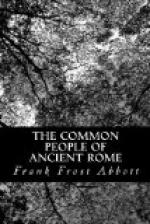[62] Buecheler, Carmina Latino epigraphica, No. 899.
[63] No. 19.
[64] No. 866.
[65] No. 863.
[66] No. 937.
[67] No. 949.
[68] No. 943.
[69] No. 945.
[70] No. 354.
[71] Corpus Inscriptionum Latinarum, IV, 6892.
[72] Buecheler, No. 928.
[73] No. 333.
[74] No. 931.
[75] No. 933.
[76] No. 38.
[77] No. 270.
[78] Habeat scabiem quisquis ad me venerit novissimus.
[79] Rex erit qui recte faciet, qui non faciet non erit.
[80]
Gallos Caesar in triumphum
ducit, idem in curiam;
Galli bracas deposuerunt,
latum clavom sumpserunt.
[81]
Brutus quia reges eiecit,
consul primus factus est;
Hic quia consoles eiecit,
rex postremo factus est.
[82] Salva Roma, salva patria, salvus est Germanicus.
[83] Cf. Schmid, “Der griechische Roman,” Neue Jahrb., Bd XIII (1904), 465-85; Wilcken, in Hermes, XXVIII, 161 ff., and in Archiv f. Papyrusforschung, I, 255 ff.; Grenfell-Hunt, Fayum Towns and Their Papyri (1900), 75 ff., and Rivista di Filologia, XXIII, I ff.
[84] Some of the important late discussions of the Milesian tale are by Buerger, Hermes (1892), 351 ff.; Norden, Die antike Kunstprosa, II, 602, 604, n.; Rohde, Kleine Schriften, II, 25 ff.; Buerger, Studien zur Geschichte d. griech. Romans, I (Programm von Blankenburg a. H., 1902); W. Schmid, Neue Jahrb. f. d. klass. Alt. (1904), 474 ff.; Lucas, “Zu den Milesiaca des Aristides,” Philologus, 61 (1907), 16 ff.
[85] On the origin of the prosimetrum cf. Hirzel, Der Dialog, 381 ff.; Norden, Die antike Kunstprosa, 755.
[86] Cf. Rosenbluth, Beitraege zur Quellenkunde von Petrons Satiren. Berlin, 1909.
[87] This theory in the main is suggested by Rohde, Der griechische Roman, 2d ed., 267 (Leipzig, 1900), and by Ribbeck, Geschichte d. roem. Dichtung, 2d ed., III, 150.
[88] Corpus Inscriptionum Latinarum, vol. III, pp. 1926-1953. Mommsen’s text with a commentary has been published by H. Bluemner, in Der Maximaltarif des Diocletian, Berlin, 1893. A brief description of the edict may be found in the Pauly-Wissowa Real-Encyclopadie der classischen Altertumswissenschaft, under “Edictum Diocletiani,” and K. Buecher has discussed some points in it in the Zeitschrift fuer die gesamte Staatswissenschaft, vol. L (1894), pp. 189-219 and 672-717.
[89] The method of arrangement may be illustrated by an extract from the first table, which deals with grain and vegetables.




